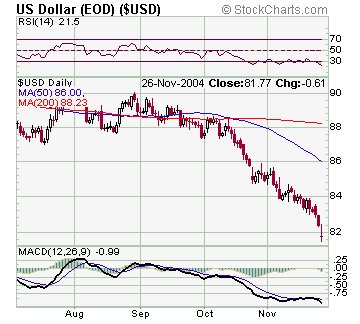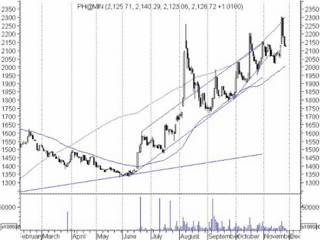Greenspan Says Foreigners May Curb Financing Deficit
Nov. 19 (Bloomberg) -- Federal Reserve Chairman Alan Greenspan said foreign investors may tire of financing the U.S. current account deficit and diversify into other currencies or demand higher U.S. interest rates. The dollar and U.S. Treasury securities fell.
``Given the size of the U.S. current account deficit, a diminished appetite for adding to dollar balances must occur at some point,'' Greenspan said at the European Banking Congress in Frankfurt. ``International investors will eventually adjust their accumulation of dollar assets or, alternatively, seek higher dollar returns to offset concentration risk, elevating the cost of financing the U.S. current account deficit and rendering it increasingly less tenable.''
Americans' demand for imported goods and a government that spends more than it takes in may be adding to the risk of a further decline in the dollar, higher interest rates and slower economic growth. The current account deficit, the widest measure of trade, grew to a record $166.2 billion in the second quarter.
The federal deficit was a record $412 billion in the fiscal year ended Sept. 30. President George W. Bush today signed an $800 billion boost in the federal debt limit to $8.18 trillion.
Against the yen, the dollar fell to 103.10 at 4:21 p.m. in New York, from 104.18 late yesterday. The U.S. currency also declined to $1.3020 per euro from $1.2961. The dollar has dropped to five records against the euro in two weeks.
Treasury Notes Fall
Treasuries fell after Greenspan said rates are poised to rise. ``Rising interest rates have been advertised for so long and in so many places that anyone who has not appropriately hedged this position by now obviously is desirous of losing money,'' he said, drawing laughs in a one-sentence response to a question about whether emerging markets are prepared.
The benchmark 10-year Treasury note fell 11/16 point, pushing the yield up 9 basis points to 4.20 percent at 4:21 p.m. in New York.
``He's telling people rates are going to keep going higher and the dollar is going to keep going lower,'' said Scott Gewirtz, co-head of U.S. Treasury trading at Deutsche Bank Securities in New York. The firm is one of 22 primary dealers of government securities that trades with the Fed's New York branch.
Markets probably will make adjustments ``without crises,'' Greenspan said, adding ``we cannot become complacent.'' He spoke on a panel that included European Central Bank President Jean- Claude Trichet and Bank of Japan Deputy Governor Kazumasa Iwata.
Avoiding a Crisis
Financial markets are so large that the impact on interest rates and currency values by central bank actions has only been ``moderate,'' and derivatives and hedge funds also have helped reduce risks, Greenspan said.
``The market economies are usually pretty good at handling these adjustments,'' said Minneapolis Fed President Gary Stern today at a separate event. ``I don't think we ought to jump to the view that something very disruptive or chaotic has to happen.''
Greenspan and U.S. Treasury Secretary John Snow are participating in meetings of the Group of 20 finance ministers and central bankers over the weekend. The dollar's slide against the euro is likely to dominate discussions, analysts said.
``The current account deficit is a chronic problem and the Fed is right to address it,'' said Mark Spindel, who manages $13 billion in debt securities as chief investment officer at International Finance Corp., an arm of the World Bank in Washington. ``The currency depreciation represents an additional risk on the inflation side.''
Taxes
Greenspan, 78 and in his fifth term as Fed chairman, endorsed the idea of tax cuts in 2001, when the U.S. was running budget surpluses. Bush eventually won passage of a $1.8 trillion, 10-year tax cut package. The U.S. has since run deficits, hurt by an eight- month recession and slow recovery.
Senator Richard Shelby, the Alabama Republican and chairman of the Senate Banking Committee, said in an interview that cutting the deficit ``would be the right signal.''
``What we need to do in the Congress is put some spending caps and walls and separate some things that are essential and nonessential,'' Shelby said.
Greenspan said today that ``reducing the federal budget deficit (or preferably moving it to surplus) appears to be the most effective action that could be taken to augment domestic saving.'' Personal savings in the U.S. rose at a 0.4 percent annual rate in the third quarter, the lowest on record.
``Significantly increasing private saving in the United States -- more particularly, finding policies that would elevate the personal saving rate from its current extraordinary low level -- of course would be helpful,'' he said.
Balanced Budget
At a hearing before the Congressional Budget Committee on Sept. 8, the Fed chairman shunned tax increases as a method of raising revenue. ``I personally would much prefer to have lower taxes and lower spending, but of necessity, a balanced budget,'' he said at the time.
Fed officials stimulated consumption by cutting the overnight lending rate to a 45-year low in June 2003 of 1 percent and leaving it there for a year. Because short-term deposit rates were negative after an adjustment for inflation, the U.S. central bank produced an incentive to spend rather than save.
Snow signaled two days ago the Bush administration won't participate in attempts to stop the dollar's slide. ``The history of efforts to impose non-market valuations on currencies is at best unrewarding and checkered,'' Snow said in London.
The U.S. is encouraging China to stop intervening in currency markets to peg its yuan at 8.3 to the dollar, a practice that keeps the prices of Chinese exports low.
As Asian economies ``move toward price stability, that implies a move toward more flexible currencies will occur,'' Japan's Iwata said.
`Worrisome'
Fed officials received a special presentation from the staff on the U.S. current account deficit in June, and subsequently began remarking on the dollar's potential to fall. The Fed called the current account deficit ``worrisome'' in the minutes of its Sept. 21 meeting released last week.
Dollars accounted for 63.8 percent of all assets in the vaults of foreign central banks and national treasuries at the end of 2003, the International Monetary Fund said, down from 66.6 percent in 2000. Foreign official holdings of euros rose to 19.7 percent in 2003, up from 16.3 percent in 2000.
The U.S. central bank raised its overnight lending rate to 2 percent on Nov. 10, the fourth increase since June. The federal funds rate target is now equivalent with the European Central Bank's refinancing rate.



